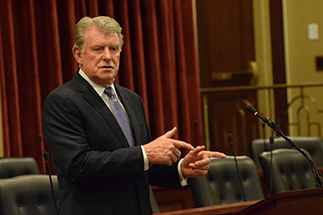


I planned to write this week on the candidates for governor and their differing approaches to healthcare. Instead, I need to clear the air regarding Gov. Butch Otter’s executive order that allows the sale of consumer-friendly insurance plans that do not comply with Obamacare.
Generally speaking, Otter’s executive order is great. It defies the federal government’s authoritarian health insurance policy requirements and allows Idahoans to pick a health insurance plan that costs less but, perhaps contains fewer Obamacare-required bells and whistles not wanted or needed by the person who buys the coverage.
However, increasingly, the executive order appears to embody the characteristics of a political stunt whose primary motive is to make Lt. Gov. Brad Little look good first, and help lower insurance costs second. Little co-signed Otter’s executive order, even though Little’s signature was not needed to effectuate the policy. Further, one wonders why the duo decided to act only last month, five months before the May Republican Primary. Obamacare has been the law since 2010.
The answer probably lies in what happened after the rollout of the executive order, which took place in January in front of a throng of reporters. Otter and Little began touring the state to celebrate their action. The touring allows Little to essentially campaign on the taxpayers’ dime, a point not lost on Little’s opponent, Tommy Ahlquist, who called the executive order “phony.”
On Thursday, Otter defended the across-the-state stumping. He told the Idaho Press Club that Little was integral to a 2017 task force that studied what to do as Congress moved to repeal and replace Obamacare. Otter said Little’s role increased after Otter was incapacitated during part of 2017 due to illness.
Otter also contends that there is nothing unique about traveling the state to promote policy. As an example, he cited a criminal justice reform effort that was pending before the 2014 Idaho Legislature. But, therein lies the difference. With Otter, and with governors before him, including Dirk Kempthorne and Phil Batt, statewide travel was generally used to promote policies for which the governor wanted public support in order to pressure the Legislature into action. In the case of the current executive order, neither Otter nor Little have asked the Legislature to do anything to solidify or validate the executive order.
It is curious, if not stunning, because executive action is always fleeting. The Otter-Little executive order could quickly be altered, or even nixed, by whomever is elected governor later this year. You have to wonder why Otter and Little are not asking the Legislature to codify their policy decision and justify the use of tax dollars for touring on that point. That would have made sense and would have given Little a legitimate excuse to engage the public, the media and even the Legislature on the topic. Indeed, why tour to promote an executive order when Otter’s separate proposal to expand Medicaid and make 35,000 people dependent on Obamacare is on thin ice in the Idaho Legislature? (Little has so far been silent on whether he supports Otter’s Medicaid-expansion-and-Obamacare-dependency plan).
Here’s another clue that reveals the executive order for what it really is: Yes, Obamacare and all its mandates are terrible. Then again, so are Idaho’s very own pre-Obamacare insurance mandates. The fact is, Idaho still requires insurance policies to meet minimum coverage requirements under Idaho law, and the state Department of Insurance has made it clear that the Otter-Little executive order doesn’t free providers to escape the state government’s requirements to cover outpatient surgery, chronic diseases, hospital and emergency room visits and so on. If federal insurance mandates are so bad, why not also address Idaho’s?
I don’t agree with Ahlquist that the executive order is phony. It’s real and appears to be helping offer Idahoans real options—less expensive options—when it comes to health insurance policies. However, the silent, politically-motivated reasons for the executive order are starting to speak volumes. Idaho’s healthcare and insurance regulatory leviathan remain protected by special interest groups and their allies in government. Unwinding it will require real work at the Statehouse, not a tour of the state to stump for votes.

